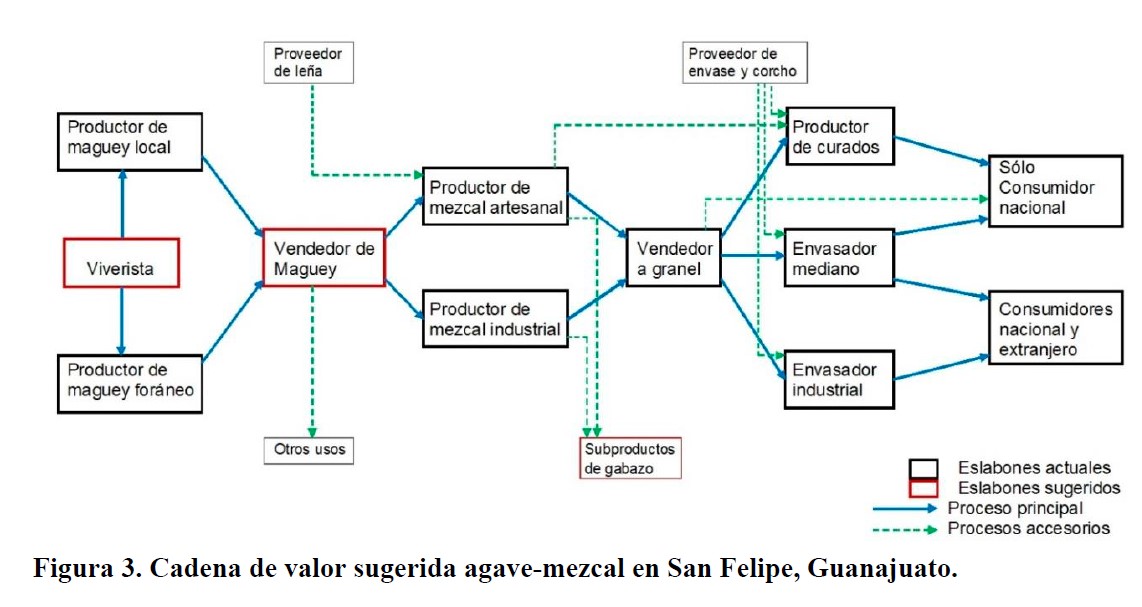Analysis of the mezcal value chain in San Felipe, Guanajuato
DOI:
https://doi.org/10.29312/remexca.v13i3.2873Keywords:
Mezcal, Diagnosis, horizontal relationship, vertical relationship, cooperationAbstract
The concept of value chain has been developed due to the need for rural companies to meet the requirements of the demand for high-quality specialized products. The value chain methodology allows us to make a diagnosis of the current situation. Subsequently, we can make an analysis of the actors involved in it and develop strategies that help improve the activity. This research work analyzes the mezcal value chain of San Felipe, from the point of view of the producers themselves to identify the links in the value chain. Information was collected through surveys and structured interviews. The information indicates that the mezcal value chain in the municipality is at a low level of competitiveness. In addition, it is disjointed in both horizontal and vertical relationships. A greater commitment on the part of the actors is recommended to be able to strengthen the relationships between the links of the chain, as well as to promote training and technical assistance in the different areas of production and to call on research and teaching institutions for the development of competitiveness strategies.
Downloads
References
Acosta, L. 2006. Agrocadenas de valor y alianzas productivas: herramientas de apoyo a la agricultura familiar en el contexto de la globalización. Santiago de Chile: Oficina regional de la FAO para América Latina y el Caribe. http://www.fao.org/tempref/GI/Reserved/FTP-FaoRlc/old/prior/comagric/pdf/agrocad.pdf.
Ariyawardana, A.; Govindasamy, R. and Lisle, A. 2015. Capturing the consumer value: the case of red lentils. British Food J. 117(3):1032-1042. https://doi.org/10.1108/BFJ-11-2013-0319. DOI: https://doi.org/10.1108/BFJ-11-2013-0319
Barrientos-Felipa, P. 2015. La cadena de valor del cacao en Perú y su oportunidad en el mercado mundial. Semestre Económico. 18(37):129-156. https://doi.org/10.22395/seec.v18n37a5 DOI: https://doi.org/10.22395/seec.v18n37a5
Coe, N. M.; Dicken, P. and Hess, M. 2008. Global production networks: realizing the potential. J. Econ. Geography. 8(3):271-295. https://doi.org/10.1093/jeg/lbn002. DOI: https://doi.org/10.1093/jeg/lbn002
Dahlström, K. and Ekins, P. 2007. Combining economic and environmental dimensions: value chain analysis of UK aluminium flows. Elsevier. Resources, Conservation and Recycling. 51(3):541-560. https://doi.org/10.1016/j.resconrec.2006.09.010. DOI: https://doi.org/10.1016/j.resconrec.2006.09.010
De Figueiredo-Junior, H. S.; Meuwissen, M. P. M.; Van-Lans, I. A. and Oude-Lansink, A. G. J. M. 2017. Beyond upgrading typologies in search of a better deal for honey value chains in Brazil. 12(7):1-22. https://doi.org/10.1371/journal.pone.0181391. DOI: https://doi.org/10.1371/journal.pone.0181391
Dries, L.; Reardon T. and Swinnen, J. F. M. 2004. The rapid rise of supermarkets in central and eastern Europe: implications for the agri-food sector and rural development. Development Policy Review. 22(5):525-556. https://doi.org/10.1111/j.1467-7679.2004.00264.x. DOI: https://doi.org/10.1111/j.1467-7679.2004.00264.x
Francés, A. 2001. Estrategias para la empresa en América Latina 1ra. Edición. Ediciones IESA. Caracas, Venezuela. 83-100, 179-185 pp.
Fennelly, D. and Cormican, K. 2006. Value chain migration from production to product centered operations: an analysis of the Irish medical device industry. Elsevier. Technovation. 26(1):86-94. https://doi.org/10.1016/j.technovation.2004.07.005. DOI: https://doi.org/10.1016/j.technovation.2004.07.005
Fries, R. and Akin, B. 2004. Value chains and their significance for addressing the rural finance challenge. (microreport #20) accelerated microenterprise advancement project (amap), usaid, and acdi/voca. Washington, DC. https://www.marketlinks.org/sites/default/ files/resource/files/ML2614-mr-20-value-chains-and-significance-12-04.pdf.
Howieson, J.; Lawley, M. and Hastings, K. 2016. Value chain analysis: an iterative and relational approach for agri-food chains. Supply Chain Management. 21(3):352-362. https://doi.org/10.1108/SCM-06-2015-0220. DOI: https://doi.org/10.1108/SCM-06-2015-0220
Iglesias, D. 2002. Cadenas de valor como estrategia: las cadenas de valor en el sector agroalimentario. Documento de trabajo. Estación Experimental Agropecuaria Anguil-Instituto Nacional de Tecnología Agropecuaria (INTA), Argentina. https://inta.gob.ar/ sites/default/files/script-tmp-cadenasdevalor.pdf.
Keshelashvili, G. 2018. Value chain management in agribusiness. Inter. J. Business Manag. 6(2):59-77. https://doi.org/10.20472/BM.2018.6.2.004.
Mac-Clay, P. and Feeney, R. 2019. Analyzing agribusiness value chains: a literatura review. International Food and Agribusiness Management Review. 22(1):31-46. https://doi.org/ 10.22434/IFAMR2018.0089.
Peña, Y.; Nieto-Alemán, P. A. y Díaz-Rodríguez, F. 2008. Cadenas de valor: un enfoque para las agrocadenas. Equidad y Desarrollo. 1(9):77-85. https://doi.org/10.19052/ed.279. DOI: https://doi.org/10.19052/ed.279
Porter, M. 1985. The value chain and competitive advantage: creating and sustaining superior performance. New York. Free Press. 33-61 pp.
Trejo-Téllez, B. I.; Ríos-Carmenado, I.; Figueroa-Sandoval, B. y Morales-Flores, F. J. 2011. Análisis de la cadena de valor del sector ovino en salinas, San Luis Potosí, México. Agric. Soc, Des. 8(2):249-260. https://www.revista-asyd.mx/index.php/asyd/article/view/1151.

Published
How to Cite
Issue
Section
License
Copyright (c) 2022 Revista Mexicana de Ciencias Agrícolas

This work is licensed under a Creative Commons Attribution-NonCommercial 4.0 International License.
The authors who publish in Revista Mexicana de Ciencias Agrícolas accept the following conditions:
In accordance with copyright laws, Revista Mexicana de Ciencias Agrícolas recognizes and respects the authors’ moral right and ownership of property rights which will be transferred to the journal for dissemination in open access. Invariably, all the authors have to sign a letter of transfer of property rights and of originality of the article to Instituto Nacional de Investigaciones Forestales, Agrícolas y Pecuarias (INIFAP) [National Institute of Forestry, Agricultural and Livestock Research]. The author(s) must pay a fee for the reception of articles before proceeding to editorial review.
All the texts published by Revista Mexicana de Ciencias Agrícolas —with no exception— are distributed under a Creative Commons License Attribution-NonCommercial 4.0 International (CC BY-NC 4.0), which allows third parties to use the publication as long as the work’s authorship and its first publication in this journal are mentioned.
The author(s) can enter into independent and additional contractual agreements for the nonexclusive distribution of the version of the article published in Revista Mexicana de Ciencias Agrícolas (for example include it into an institutional repository or publish it in a book) as long as it is clearly and explicitly indicated that the work was published for the first time in Revista Mexicana de Ciencias Agrícolas.
For all the above, the authors shall send the Letter-transfer of Property Rights for the first publication duly filled in and signed by the author(s). This form must be sent as a PDF file to: revista_atm@yahoo.com.mx; cienciasagricola@inifap.gob.mx; remexca2017@gmail.
This work is licensed under a Creative Commons Attribution-Noncommercial 4.0 International license.


